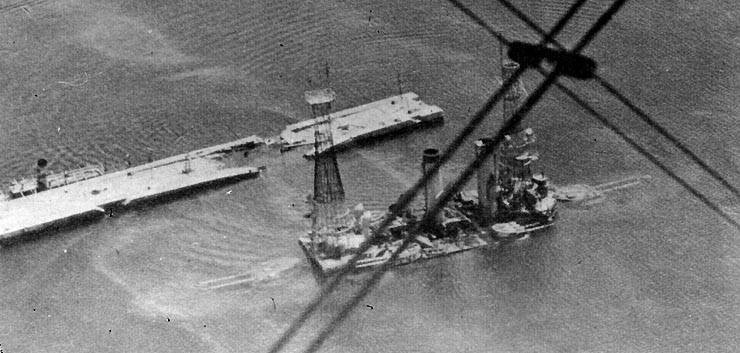Mississippi II (Battleship No. 23)
1908-1914
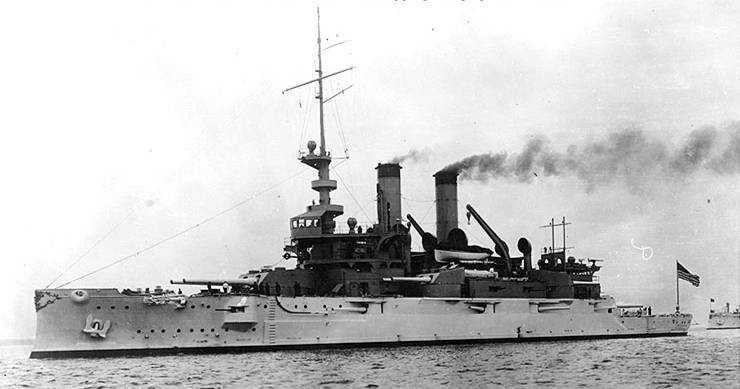
The first Mississippi was named for the Mississippi River; succeeding ones for the 20th State, admitted to the Union on 10 December 1817.
II
(Battleship No. 23: displacement 14,465 (full load) 13,000 (normal); length 382'0"; beam 77'0"; draft 24'8"; speed 17.0 knots; complement 744; armament 4 12-inch, 8 8-inch, 8 7-inch, 12 3-inch, 2 3-pounders, 2 1-pounders, 2 21-inch submerged torpedo tubes; class Mississippi)
The second Mississippi (Battleship No. 23) was laid down on 12 May 1904 at Philadelphia, Pennsylvania, by the William Cramp and Sons Ship and Engine Building Co.; launched on 30 September 1905; sponsored by Miss Mabel Clare Money, daughter of Senator Hernando DeSoto Money of Mississippi; and commissioned at the Philadelphia Navy Yard, League Island, on 1 February 1908, Capt. John C. Fremont in command.
Mississippi departed League Island on 15 February 1908 for Hampton Roads, and after embarking a draft of men at Fort Monroe, Virginia (17-19 February), sailed for Guantanamo Bay, Cuba, where she conducted the first part of her "shaking down" (24 February-9 March). Returning to League Island on 15 March for fitting out, Mississippi embarked upon the second phase of her "shaking down" upon departure from Philadelphia on 1 July. Over the ensuing weeks, she visited the Rhode Island locales of Bradford (2-4 July, 10-13 July, 30 July-1 August, and 7-8 September), Block Island (6-9 July), and Newport (13-14 July, 16-17 July, and 21-24 July), New York City (18-20 July), Philadelphia (26-28 July), and the Massachusetts locales of Provincetown (2-5 August, 8-10 August, 22 August-2 September, and 5-6 September), Cape Cod Bay (5-8 August), Boston (2-5 September), and the Maine ports of Rockland (11-15 August), Sabbath Day Harbor (15-17 August) and Bar Harbor (19-21 August). She returned to the Philadelphia Navy Yard on 10 September, and remained there, undergoing repairs, into the following year, a yard period punctuated only by the battleships move to an anchorage off Philadelphia's Race Street to participate in the festivities incident to "Founder's Week" (3-9 October).
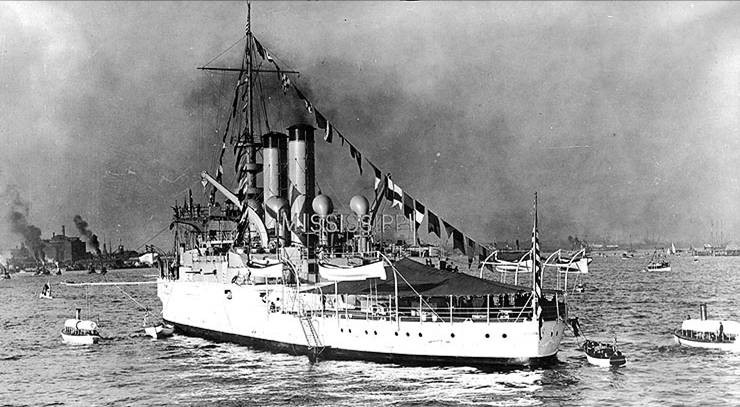
Mississippi stood out from Philadelphia on 16 January 1909, and after a brief pause in Hampton Roads (18-19 January), pushed on for Key West, Florida, where she joined Maine (Battleship No. 10) on 24 January. Sailing on 25 January, the two battleships arrived at Habana [Havana] the same day, and represented the United States at the inauguration of Jose Miguel Gomez as President of Cuba, an event that had showed, as President Theodore Roosevelt declared upon Gomez's election the previous November, "in impressive fashion the seriousness with which the Cuban people have now prepared themselves once more to assume the duties of a free and independent Republic." Mississippi sailed for Guantanamo Bay on 28 January, standing in two days later, and operated in those waters until 10 February. Assigned to the Third Squadron of the Atlantic Fleet (Rear Admiral Conway H. Arnold), she then joined her sister ship Idaho (Battleship No.24), and Maine and New Hampshire (Battleship No. 25), in meeting the returning Atlantic Fleet on 17 February at longitude 35º N, latitude 55ºW, then proceeding to Hampton Roads where President Roosevelt reviewed the "Great White Fleet" on Washingtons Birthday (22 February 1909).
Departing Hampton Roads on 1 March 1909, Mississippi returned to Guantanamo Bay a week later (8 March). She then operated with a Special Service Squadron on the target grounds off Cape Cruz , Cuba (2-10 April and 17-18 April), out of Guantanamo, until 1 May, when she received orders to carry out a cruise up the Mississippi River. Pausing at the Louisiana locales of South Pass (5-6 May), New Orleans (6-12 May), Donaldsonville (12-14 May), Plaquemine (14-15 May), Baton Rouge (15-18 May), and Bayou Sara (18-20 May), the battleship reached Natchez, Mississippi, on 20 May, and then proceeded five days later to Horn Island where she received a silver service from the state whose name she carried. Returning to Philadelphia on 7 June, the battleship then proceeded to Eastport, Maine, for Independence Day observances.
Mississippi sailed from Eastport on 6 July 1909, then conducted sub-caliber practice in Cape Cod Bay (7-10 July) before spending the rest of the month of July with the Atlantic Fleet in those waters, preparing for target practice, punctuated by visits to Provincetown for liberty (10-15 July, 17-19 July, 24-27 July, and 31 July-4 August). Departing Provincetown on 4 August, the battleship then coaled at Hampton Roads (7-9 August), and operated thence, firing record target practices (9-19 August) and both day and night battle practices (21 August-6 September) on the Southern Drill Grounds. She then drilled with New Hampshire in those waters (7-12 September) before receiving orders to proceed to New York City.
Along with other units of the Atlantic Fleet, Mississippi then participated in the Hudson-Fulton Observances in the North River (22 September-4 October 1909) before she proceeded to the Philadelphia Navy Yard for repairs (5-20 October). Steaming thence, she returned to New Orleans, where she "showed the flag" in connection with the "Lakes to the Gulf" Convention (26 October-2 November) before returning to Philadelphia for work that kept her in navy yard hands for the rest of the year 1909.
Standing down the Delaware River on 5 January 1910, bound for Cuban waters, Missisippi operated with the Atlantic Fleet out of Guantanamo Bay (12 January-24 March), engaged in drills and exercises, before returning to Hampton Roads on 4 April. The battleship then conducted target practice on the Southern Drill Grounds (4-28 April), after which time she paused briefly at Hampton Roads (28 April). She then returned to the Philadelphia Navy Yard for another period of repairs that lasted until 16 July. After conducting torpedo drill out at Gardiner's Bay, Maine (18-21 July), Mississippi then embarked men of the Rhode Island Naval Militia to afford them the "opportunity for training with the latest and best naval material, and also bringing them into close touch with the Regular Navy..." Putting to sea on 23 July with the militiamen embarked, the battleship cruised with the Atlantic Fleet until returning to Newport six days later, on 29 July. After coaling at Bradford, Rhode Island (30 July), she then conducted torpedo and mine practice out of Cape Cod Bay (31 July-14 August), after which point she again replenished her coal bunkers at Newport (15-22 August).
Mississippi sailed south soon thereafter, bound for Hampton Roads and the Southern Drill Grounds, in the former waters for such activities as bore sighting (6-8 September 1910), obtaining a range finder (11-12 September), to coal and obtain boats (25-27 September), and underway in the latter for preparing for battle practice (24 August-6 September and 8-11 September) and conducting battle practice (12-25 September). The ship then visited New York City, affording her crew an opportunity for liberty there (28 September-5 October), but required repairs at the Philadelphia Navy Yard, a period of work that kept her there for nearly a month (5 October-1 November). Underway again on 1 November, Mississippi sailed for European waters with the Third Division of the Atlantic Fleet, concluding the year with visits to Gravesend, England (16 November-7 December) and Brest, France (9-30 December). During the passage from the English Channel to Cuban waters, Mississippi served as part of the "enemy" battleship force while "the armored cruiser and scout divisions, and a division of destroyers comprising a scouting force" (Rear Adm. Sidney A. Staunton) in a scouting or search problem conducted "under conditions simulating war as far as practicable, the course and speed of the 'enemy' being unknown to the scouts within moderate limits." Rear Adm. Staunton's cruisers managed to succeed in "finding and keeping in touch with the 'enemy' and reporting his movements" in a "practical demonstration of a number of important points in scouting and the use of wireless communication in that connection..."
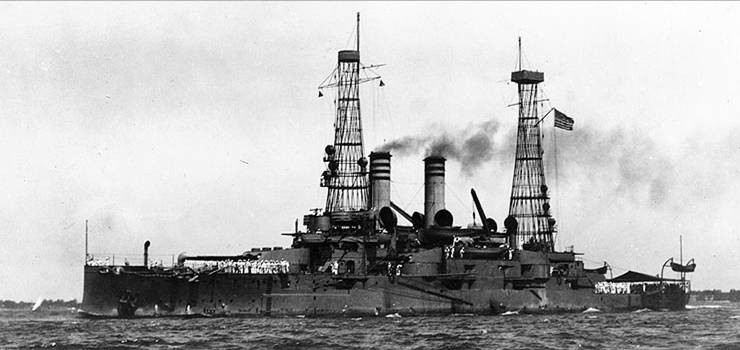
Reaching Guantanamo Bay on 13 January 1911, Mississippi spent the next two months engaged in exercises with other units of the Atlantic Fleet (13 January-13 March), disembarking her Marine detachment on 13 March to be formed, along with the Marines from ten other battleships, into the Third Regiment (Lt.Col. Ben H. Fuller, USMC, in command). Sailing that day sans her Marines, Mississippi stood in to Hampton Roads on 17 March. For almost a month, the battleship then alternated between Hampton Roads or the Southern Drill Grounds, periods of maintenance and upkeep and drills punctuated by spotting practice in Tangier Sound (20-23 March) and boresighting her battery in Lynnhaven Bay (31 March). Completing battle practice on 11 April, Mississippi picked up her boats the same day and exited those waters, bound for Philadelphia. Following a drydocking period (12 April-1 May), the battleship then joined the Third Division of the Atlantic Fleet off the Delaware Breakwater (1-2 May) before sailing down the eastern seaboard. After a period of time cruising with the Third Division out of Pensacola, Florida (8 May-5 June), and Galveston, Texas (7-12 June), Mississippi conducted torpedo exercises off Pensacola (13-17 June) before putting in to that port to coal (17-22 June). Then, after conducting a battle plan exercise (22-23 June), she put in to New York City to embark a contingent of Marines (28 June), steaming thence to deliver the leathernecks to Georgia (Battleship No. 15) at Provincetown (29-30 June).
After participating in Independence Day observances at Rockport, Massachusetts, Mississippi sailed on 6 July 1911 to conduct maneuvers with the Atlantic Fleet off Provincetown (6-12 July), after which time she put in to Tompkinsville, New York, to embark a contingent of the New York Naval Militia. Following that training cruise (13-22 July), she disembarked the militia sailors where they had joined the ship, Tompkinsville, and then returned to the familiar waters of Cape Cod Bay, to base there for the summer. She conducted joint exercises with torpedo boats (1-11 August) off Provincetown and in Cape Cod Bay, periods of work punctuated by liberty at the former place (3-7 August). Then, following a liberty visit to Marblehead, Massachusetts (11-14 August), Mississippi conducted "aeroplane practice" in Cape Cod Bay (14 August) before putting in to Provincetown to coal (14-16 August). She alternated between Cape Cod Bay and Provincetown until sailing southward on 20 August. Loading ammunition at Philadelphia (22-23 August), the ship rejoined the fleet at Hampton Roads on 24 August.
After witnessing the firing conducted by Delaware (Battleship No. 28) in Tangier Sound (27-28 August 1911), Mississippi boresighted her guns (28-31 August) in Hampton Roads, and then conducted target practice on the Southern Drill Grounds (31 August-6 September), after which time she returned to Philadelphia for drydocking (7 September-8 October). She returned to Hampton Roads upon completion of that period in the yard (9 October), and rejoined the fleet there. Then, following a period of tactical drills on the Southern Drill Grounds (21-22 October), Mississippi sailed for New York, arriving on the 24th as part of the concentration of the fleet ordered by Secretary of the Navy George Von Lengerke Meyer on 2 October. On 1 November, Secretary Meyer inspected the gathered ships, and on the 2nd, President William Howard Taft reviewed the assemblage in the North River, both as they lay anchored and then stood out in formation. "The review was a complete success and was an object lesson to the people," Meyer declared later, "in that there was assembled the largest and most powerful collection of vessels ever possible under the United States flag. It was a concrete example," he added, "of what the money of the taxpayers [of whom some 100,000 visited the ships and more than 2,000,000 had seen them from shore vantage points] had been spent for." President Taft stated on 2 November: "Those who saw the fighting fleet which was assembled in New York Harbor today could not fail to be struck with its preparedness and with its high military efficiency, and must be proud of its personnel."
Mississippi returned to more southern regions soon thereafter, operating with the Second Squadron in Hampton Roads (3-6 November 1911) before she conducted tactical exercises on the Southern Drill Grounds 6-8 November). The battleship operated again with the Second Squadron (8-12 November), then conducted torpedo exercises in Tangier Sound (12-15 November), before rejoining the Second Squadron and sailing for Newport, en route to which she engaged in a scouting problem (18-19 November). Mississippi held torpedo practice on the range off Newport (21-24 November), after which time she lay anchored at that port, providing liberty for her crew (24 November-7 December). Departing on the latter date, Mississippi sailed for Philadelphia, arriving the following day to begin a period of repairs that kept her in yard hands through the remainder of the year 1911 and into 1912.
The battleship departed Philadelphia on 16 March 1912, and rejoined the fleet at Hampton Roads. She operated in those waters, as well as in Tangier Sound, in Lynnhaven Bay, and on the Southern Drill Grounds through the third week of April, conducting spotting practice, holding target practice, taking time to search for lost rafts, conducting torpedo practice, conducting target practices for submarines and Roe (Destroyer No. 24) and Terry (Destroyer No.25), and concluding the period with preparations for steaming trials (22-24 April) slated to take place off Rockland, Maine. Sailing on 24 April, Mississippi conducted steaming trials off Provincetown (26 April-9 May), then shifted to Rockland, where she held standardization runs (9-15 May), after which time she rendezvoused with her squadron off Provincetown (15-17 May). After provisioning and providing an opprtunity for liberty at Boston Navy Yard (17-20 May), Mississippi then returned to Provincetown for exercises.
"Disturbed conditions" existing in Cuba, however, dictated Mississippi's next movements. She proceeded to Tompkin sville , N.Y. , where, on 26 May 1912 she embarked an expeditionary force of Marines from the Second Marine Regiment (40 officers and 1,252 enlisted men) distributed between Mississippi and seven other battleships, and Washington (Armored Cruiser No.11) before standing out for Key West, Florida. She paused at that port, awaiting orders, from 30 May to 5 June, sailing on the latter date for Guantanamo. She then disembarked her Marines at El Cuero on 19 June, then returned to Guantanamo Bay where she remained until 5 July, when "conditions [in Cuba] [having] so improved as to permit" it, she sailed for home to "return to [her] usual exercises."
Mississippi then resumed regular operations with the fleet, with the Fourth Division off Point Judith, Rhode Island (10-11 July 1912) and New London, Connecticut (14-22 July), punctuated by a period of fleet maneuvers off Block Island (11-12 July) and Newport (12-14 July) and followed by further work with the fleet off Point Judith (22-26 July) and Newport (26-31 July). The battleship then proceeded to the Philadelphia Navy Yard, where she entered the First Reserve on 1 August 1912.
Mississippi remained in the Atlantic Reserve Fleet at Philadelphia until detached on 30 December 1913 for duty as "aeronautic station ship" at Pensacola , Fla. Departing Philadelphia for Annapolis, Maryland, on 6 January 1914, to embark the men (nine officers and 23 enlisted) and load equipment (aircraft, hangars, and other necessary equipment) earmarked for establishing an aviation base at Pensacola, Fla., on the site of the dilapidated former naval station. With the foregoing on board Mississippi and Orion (Collier No. 11), the ships arrived at their ultimate destination on 20 January, and their men, along with the aviators and mechanics, began transforming the old naval base into an "Aeronautic Center." Sadly, the new facility suffered its first fatality less than a month later when Lt. (j.g.) James McC. Murray drowned after his Burgess D-1 flying boat plunged into Pensacola Bay from an altitude of 200 feet on 16 February 1914.
At one point, as U.S. diplomatic relations with Mexico worsened in the spring of 1914, Lt. Comdr. Henry C. "Rum" Mustin, Missisippi's commanding officer and commandant of the fledgling aviation base at Pensacola, was having lunch with Capt. William S. Sims, the commander of the Atlantic Torpedo Flotilla on board Sims's flagship, the cruiser Birmingham, on 19 April 1914 when he received orders to prepare "one aeroplane section" for duty at Tampico. Inspecting Birmingham soon thereafter, Mustin, "having suspected something like this would happen," determined "the conditions for stowage and handling of aeroplanes" on board and sent word to the station to begin preparing them for deployment. Having seen no facilities on board Birmingham to hoist planes out or recover them, Mustin arranged for the removal of Mississippi's port lower [boat] boom and its installation on the cruiser's mainmast "as a derrick" by the latter's ship's force. Additionally, uncertain of the character of the work to be performed by the "aeroplane section" (Lt. John H. "Jack" Towers, officer-in-charge) Mustin ordered a Curtiss C-Type flying boat (C-5), and a Curtiss standard hydroaeroplane (A-4) with a complete set of spares and material to construct a land chassis for the latter.
Mississippi's transferring small arms and ammunition to the ships of the torpedo flotilla seemed to reflect no need for her in Mexican waters. Consequently, Mustin gave the "best of the material available" to Birmingham and her embarked aviation unit. While preparations proceeded incident to Birmingham's deployment, however, orders arrived soon thereafter for Mississippi to sail for Mexican waters as well, to transport the remainder of the Second Regiment of Marines (16 officers and 516 men strong) from the advanced base outfit, who had remained in barracks at Pensacola when its first increment (4 officers and 329 men) had sailed for Vera Cruz in the transport Prairie in early March 1914.
Orders also directed Mississippi to embark "one aeroplane section similar to that sent to the Birmingham..." Consequently, the battleship embarked Lt. Patrick N. L. "Pat" Bellinger (officer-in-charge) and student aviators Lt. (j.g.) Richard C. "Caswell" Saufley, Ens. Melvin L. Stoltz and Ens. Walter D. LaMont, the Curtiss C-3 flying boat and the Curtiss standard hydroaeroplane A-3, spare wings for the latter from the disassembled C-1. Mississippi's ship's force rigged her remaining lower [boat] boom to the mainmast to provide a hoist for A-3 on the port side of the quarterdeck, and a heavy spar to the starboard boat crane to serve as a hoist for C-3, while the battleship left behind one of her steam launches to provide room to assemble the latter. Although Mississippi had been ready for sea by the evening of 20 April 1914, the torpedo flotilla's locust-like descent upon Pensacola for fresh provisions compelled Mustin to "get most of our stuff" at Mobile, Alabama, the following morning.
Mississippi sailed from Pensacola one hour before the end of the forenoon watch on 21 April 1914, Marines and aeroplane section embarked. During the forenoon watch on 24 April, the aviation unit's officers and "mechaniciens" assembled C-3 and A-3, hooked them onto the hoists, and tested the motors, readying them for service upon arrival. The ship reached Vera Cruz mid-way through the first dog watch, Mustin reporting to Rear Adm. Charles J. Badger, Commander in Chief, U.S. Atlantic Fleet, upon arrival "that both aeroplanes were ready for service and suggested searching for the mine that the department, by radiogram, had stated was planted to the eastward of the breakwater." Rear Adm. Badger told Mustin to report to Rear Adm. Frank F. Fletcher, in command on shore, "and make such disposition of the aeroplanes as he should direct..."
Lt. Comdr. Mustin reported to Rear Adm. Fletcher the following morning (25 April 1914) as ordered, and informed the admiral that during the voyage down from Pensacola, the aviation unit "had manufactured a land chassis for A-3 and could convert this aeroplane into a land machine in about one hour's notice in case it was required for distant work inshore," and also that they had "manufactured bombs, using the war noses of the ship's torpedoes for detonators." Mississippi's captain returned to his ship, which then shifted to a berth inside the breakwater, and Lt. (j.g.) Bellinger flew a 28-minute solo reconnaissance flight over the Mexican port at 3,000 feet in C-3. He conducted a second flight in C-3 with Ens. Stoltz on board, a 50-minute flight over Vera Cruz at 1,200 feet. On both occasions, Bellinger looked for mines, but the roughness of the water precluded a successful search.
The following morning (26 April 1914), by Rear Adm. Fletcher's authority, Mississippi transferred "both aeroplanes...to the beach" south of the "bathing pavilion...inside the outer breakwater." Dispensing with hangars, the planes safer in the event of a "norther" [storm] by having them "anchored tail to wind in the open..." the aviation detachment set up shop on shore, tents accommodating two "mechaniciens" of the ten available to rotate duty ashore with the planes each night, the stores, and the officer in charge of the seaman guard detail from one of the regiments ashore.
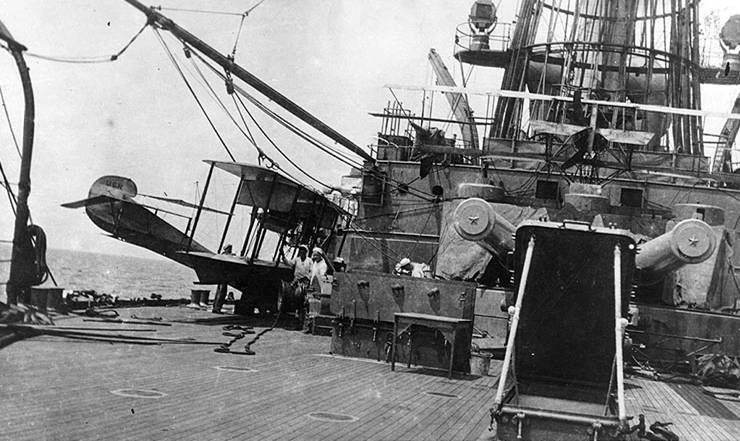
On 6 May 1914, on Bellinger's sixth flight of that morning, with Lt. Saufley as his observer in A-3, he departed the beach at 9:13 a.m., scouted to the northward of Vera Cruz, then followed the coastline at 3,200 feet. The search yielded the sight of neither encampments nor body of men larger than five, and none wore uniforms. After Bellinger and Saufley returned to the aviation encampment, Bellinger's chief mechanicien showed him holes in the upper and lower wings, which appeared to have been made by bullets. "The evidence was convincing," Bellinger later noted, "and gave me a record of a sort as this was the first instance that a U.S. plane was struck by hostile gun fire." A subsequent flight with Saufley on board also came under fire. "I wanted to return the favor," Bellinger wrote in his memoirs, "but we were under orders not to use our revolvers offensively." Finding neither a stone nor a brick with which to "bomb" the enemy, the pilot soon received a bar of Octagon soap from one of the men. The next time Saufley flew as an observer, he threw the soap at the Mexicans. During the flights before and after the hostile fire incident, Bellinger conducted photographic missions, using his personal Eastman A-3 camera, in addition to reconnaissance missions, looking for reported troop concentrations, reconnoitering railroad lines, and flights to look for mines, and took aloft a number of individuals, one at a time, including the Marine artist Henry Reuterdahl. Yet despite the primitive operating conditions, the pilot and his passengers received excellent support, which the former acknowledged with wry humor. "I guess it was a combination of good luck and good men," Bellinger reminisced many years later, "that made it possible for me to fly every day for 46 days."
"This expedition," Mustin later reported, "has been very valuable in supplying information as to future requirements of Naval aeroplanes and their accessories required for maintenance on board ship and in the field with advance base outfits...one or more flights have been made every day since the arrival of the Mississippi at Vera Cruz, regardless of weather conditions." Rear Adm. Badger, in forwarding the reports of the work accomplished by the aviators and their machines, praised the efforts of Mississippi's men: "The Navy Aviation Corps on board...have performed their duties well and their observations while in flight have been of service to the land forces."
One month after her arrival there, Mississippi departed Vera Cruz to return to Pensacola . Serving as aeronautic station ship there from 15 to 28 June 1914, she then sailed north to Hampton Roads. On 3 July, as the battleship neared the Virginia capes, Lt. (j.g.) Bellinger flew mail to the post office at Old Point Comfort, a 30-mile trip. That same day, Mississippi transferred her aviation gear to North Carolina (Armored Cruiser No.12).
While Mississippi lay at Vera Cruz, events elsewhere were occurring that soon determined her future. Diplomatic tensions between Greece and the Ottoman Empire after the 1912-13 Balkan Wars found expression in each seeking to buy powerful warships abroad that would enable them to control the Aegean Sea. Determined as unsatisfactory for continued U.S. service, Mississippi and her sister ship, Idaho, were sold to Fred J. Gauntlett, an intermediary, on 8 July 1914, who then turned around and transferred them to the Greek government. "Those battleships," wrote then-U.S. Ambassador to Turkey Henry Morgenthau, "immediately took their places as the most powerful vessels of the Greek Navy, and the enthusiasm of the Greeks in obtaining them was unbounded." Two days after the sale, on 10 July 1914, Mississippi shifted to Newport News. There, she was decommissioned on 21 July 1914. She was turned over to the Royal Hellenic Navy the same day. "The U.S. sale of the Mississippi and Idaho to Greece," taken together with the German gift of the powerful battle cruiser Goeben and cruiser Breslau, proved "a major factor in Turkey's decision in October 1914 to enter [World War I] as Germany's partner."
Renamed Kilkis to commemorate the Greek victory over Bulgarian troops in the Second Balkan War (4 July 1913), the battleship served in the Royal Hellenic Navy during the Allied Crimean Expedition to assist White Russian forces against Russian Bolsheviks in 1919 and served off Constantinople and Smyrna during the Greco-Turkish War of 1919-22. The battleship became a training ship in the mid-1930s and was later relegated to harbor duty at Salamis. Following the German declaration of war on Greece, the battleship was bombed and sunk in shallow water on 23 April 1941 at Salamis , Greece , by German Junkers Ju-87 Stuka dive bombers from Luftflotte 4. After World War II, her hulk was salvaged as scrap.
Rewritten, Robert J. Cressman, 22 August 2007
